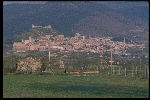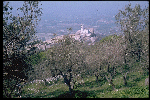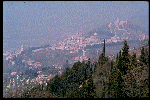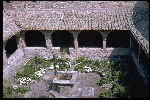| No text |
ITALY
1. Tuscany, Umbria, The Marches. Part II
(Click here to go to Part I)
Florence-Siena-Montepulciano-Assisi-Gubbio-
Urbino-Rimini. Km.: 550 - Days: 6 - Month: May
Day 4: Assisi to Gubbio - 42 km.
In spite of being the shortest leg of the tour, the one from Assisi
to Gubbio is undoubtedly the most challenging. I leave Assisi from the
same road I came by, and take the first turn on the right to Palazzo.
After entering the village of Petrignano I turn right again
and cycle on until I cross the road to Perugia. I turn left in the
direction of Perugia for a short stretch and at the first crossroad
I take a secondary road to the right. At every turn since Assisi
I have found a sign pointing to Gubbio, so finding my way
wasn't as difficult as I have made it sound. What is going to
become difficult very shortly is the ride itself. When you reach
Piccione you'll know you are on the right way, and, for once,
this won't be much of a consolation. A series of steep switchbacks that
seems to have no end starts just after this small village. For about
5 km. the road climbs until Belvedere di Gubbio. The gain in
altitude is considerable, and you can take the measure of it as the
horizon recedes and the view stretches further and further to embrace
the hills of Perugia and the valley of the river Tevere
to the west, and the imposing mass of mount
Subasio, dwarfing the city of St. Francis perched
at its feet, to the south. The road flattens deceivingly
just before Belvedere, then the climb implacably resumes
for another couple of km. The steep descent begins when
Gubbio is not much more than 10 km. away. Before plunging
into it you may want to take some minutes to enjoy the
view of the 1500+ mt. high peaks marking the border
between Umbria and Marche, at the feet of
which the towers of Gubbio appear. After you start your
descent you'll have to watch the road mostly, and in any case,
you'll be entering Gubbio before you have the time to
say: -whoaaaa...
Day 5: Gubbio to Urbino - 75 km.
There are two ways to get from Gubbio to the via
Flaminia, which, since roman times, links Rome
to the northern shores of the adriatic. Both cross the
apparently formidable backbone of the Appennino
Marchigiano, but the one I take proves a much less
challenging climb that the one of the previous day. I
shun the Scheggia road that begins right in
Gubbio, and take the one that follows the bottom
of the valley, heading north.
After a couple of km. I turn to the
left following the signs reading Pesaro and
Urbino. The only difficulty on this road is the
rather long Contessa gallery, into which I venture
cautiously because of the dim lighting.
The road is wide, though, and the
cars that pass me coming from behind keep well to my left.
The modern via Flaminia is a fast traffic motorway with
entrance ramps and bypasses at every town and village along
the way. But, as I soon discover, the old Flaminia is still
in place, winding alongside the new road and crossing it from
time to time to link the villages on the flanks of the valley.
It is almost free of traffic, although as a consequence, its
state of repair is rather poor (don't worry though, those
roman flagstones have disappeared since quite a long time).
Staying on the old Flaminia, I cross the Furlo Gorges,
which the motorway avoids entering instead a long tunnel
which is absolutely off-limits for cyclists. The Gorges
landscape gives a sudden impression of wilderness and remoteness,
that lasts as long as you stay there, which won't be long
unless you slow down (they are not the Grand Canyon).
The road to Urbino is to be found just after the Gorges,
turning left away from the Flaminia. It's mostly a gentle
faux-plat, and only the last 3 km. or so are real
climb. The traffic, however, seems to increase in direct
proportion to the gradient, and in the very last stretch I
feel my breath getting shorter and shorter as the fumes
get denser.
Day 6: Urbino to Rimini - 80 km.
The following day it's more of the same as far as road
traffic is concerned. The road to Pesaro is very
busy and, having started off rather early on a working day
I find myself engulfed by the commuting traffic.
The situation doesn't change until I get to Pesaro.
Then it just gets worse.
I know what I am looking for though. I steer clear of the
main coastal road and go on in the direction of the city
centre and the harbour. I follow the signs that read
Capitaneria di Porto (the Coast Guard HQ), until
there's no way to go but left, through a quiet suburb
near the sea. Soon I am out of the urban area and start
to climb a wooded hill. After a couple of turns the
blue expanse of the Adriatic sea appears on my right.
I am following the road en corniche carved along
the flanks of the headland that separates the Marches
coast from the Riviera of Emilia Romagna, and
constitutes the only rugged stretch of coast between
Trieste and Ancona. I consider these 15 km. among the
most beautiful of my itinerary that has crossed some of
the most renowned parts of Italy. After the village of
Fiorenzuola di Focara, perched on a windy cliff
plunging vertiginously into the sea (a site mentioned
by Dante in his Commedia, as the inscription on
the gate attests), the view stretches from one side to
the sea, and from the other to the hills of
Montefeltro, with the medieval fortress of
Gradara in the foreground. The last part is a bit
of a rollercoaster ride as the road descends almost to the
sea level then climbs again on the last crumble of the headland
where Gabicce Monte is perched. Looking northward
from the top, the white sandy beach (with its belt
of hotels and condos) stretches in a long crescent as far as
the eye can see (and farther, unless your eye can see as
far as Ravenna, which is almost 80 km. away). The wide
avenues of the Riviera provide a fitting enough setting
for the conclusion of my tour. There are no big crowds,
but that's just because the summer season is only at the
beginning. Which is much the better to take advantage of
the empty beaches for a well deserved rest.
Since from the Rimini station trains taking
bikes run to Bologna every two hours all day long,
I just have to decide how much resting I need.
Go to Part 1
|
No text |

Click on photos to zoom

A view of Assisi stretching
at the feet of Monte Subasio

The franciscan Basilica
appears behind a curtain
of olive trees.

The layers on which the town
of Assisi is built reflect the
social stratification of medieval
society. From top to bottom:
nobility, gentry and commoners

In the fashion of a zen garden,
S. Damiano's cloister
gives shape to the spiritual
values of the Franciscan
movement:
simplicity and the quest for the absolute.
Click here to go
Back to Part 1
|






